Related Research Articles

The osprey, also called sea hawk, river hawk, and fish hawk, is a diurnal, fish-eating bird of prey with a cosmopolitan range. It is a large raptor reaching more than 60 cm (24 in) in length and 180 cm (71 in) across the wings. It is brown on the upperparts and predominantly greyish on the head and underparts.
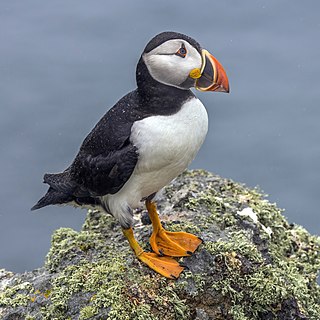
The Atlantic puffin, also known as the common puffin, is a species of seabird in the auk family. It is the only puffin native to the Atlantic Ocean; two related species, the tufted puffin and the horned puffin, are found in the northeastern Pacific. The Atlantic puffin breeds in Russia, Iceland, Norway, Greenland, Newfoundland and Labrador, Nova Scotia, and the Faroe Islands, and as far south as Maine in the west and France in the east. It is most commonly found on the Westman Islands, Iceland. Although it has a large population and a wide range, the species has declined rapidly, at least in parts of its range, resulting in it being rated as vulnerable by the IUCN. On land, it has the typical upright stance of an auk. At sea, it swims on the surface and feeds on small fish and crabs, which it catches by diving under water, using its wings for propulsion.

The horned grebe or Slavonian grebe is a relatively small waterbird in the family Podicipedidae. There are two known subspecies: P. a. auritus, which breeds in the Palearctic, and P. a. cornutus, which breeds in North America. The Eurasian subspecies is distributed over most of northern Europe and the Palearctic, breeding from Greenland to western China. The North American subspecies spans most of Canada and some of the United States. The species got its name from large patches of yellowish feathers located behind the eyes, called "horns", that the birds can raise and lower at will.
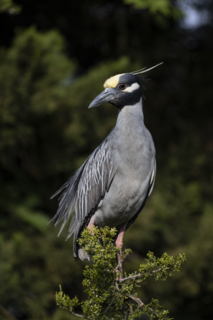
The yellow-crowned night heron, is one of two species of night herons found in the Americas, the other one being the black-crowned night heron. It is known as the bihoreau violacé in French and the pedrete corona clara in Spanish.

The killdeer is a large plover found in the Americas. It was described and given its current scientific name in 1758 by Carl Linnaeus in the 10th edition of his Systema Naturae. Three subspecies are described. The killdeer's common name comes from its often-heard call. Its upperparts are mostly brown with rufous fringes, the head has patches of white and black, and two black bands cross the breast. The belly and the rest of the breast are white. The nominate subspecies breeds from southeastern Alaska and southern Canada to Mexico. It is seen year-round in the southern half of its breeding range; the subspecies C. v. ternominatus is probably resident in the West Indies, and C. v. peruvianus inhabits Peru and areas of the surrounding countries throughout the year. North American breeders winter from their resident range south to Central America, the West Indies, and the northernmost portions of South America.

The piping plover is a small sand-colored, sparrow-sized shorebird that nests and feeds along coastal sand and gravel beaches in North America. The adult has yellow-orange-red legs, a black band across the forehead from eye to eye, and a black stripe running along the breast line. This chest band is usually thicker in males during the breeding season, and it is the only reliable way to tell the sexes apart. The bird is difficult to see when it is standing still, as it blends well with open, sandy beach habitats. It typically runs in short, quick spurts and then stops.
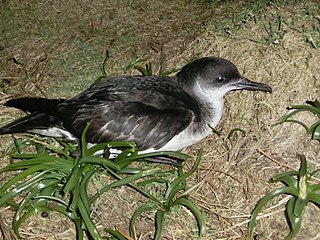
The Manx shearwater is a medium-sized shearwater in the seabird family Procellariidae. The scientific name of this species records a name shift: Manx shearwaters were called Manks puffins in the 17th century. Puffin is an Anglo-Norman word for the cured carcasses of nestling shearwaters. The Atlantic puffin acquired the name much later, possibly because of its similar nesting habits.
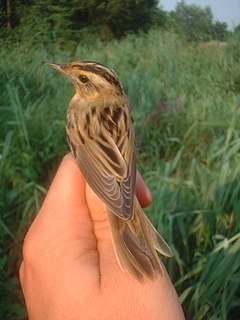
The aquatic warbler is an Old World warbler in the genus Acrocephalus. It breeds in temperate eastern Europe and western Asia, with an estimated population of 11,000-15,000 pairs. It is migratory, wintering in west Africa. After many years of uncertainty, the wintering grounds of much of the European population were finally discovered in Djoudj National Bird Sanctuary, Senegal, with between 5,000 and 10,000 birds present at this single site. Its south-westerly migration route means that it is regular on passage as far west as Great Britain and Ireland.

Rutland Water is a reservoir in Rutland, England, east of Rutland's county town, Oakham. It is filled by pumping from the River Nene and River Welland, and provides water to the East Midlands. By surface area it is the largest reservoir in England, but its capacity is exceeded by that of Kielder Water in Northumberland.

The whooping crane is the tallest North American bird, named for its whooping sound. It is an endangered crane species. Along with the sandhill crane, it is one of only two crane species native to North America. The whooping crane's lifespan is estimated to be 22 to 24 years in the wild. After being pushed to the brink of extinction by unregulated hunting and loss of habitat to just 21 wild and two captive whooping cranes by 1941, conservation efforts have led to a limited recovery. The total number of cranes in the surviving migratory population, plus three reintroduced flocks and in captivity, now exceeds 800 birds.
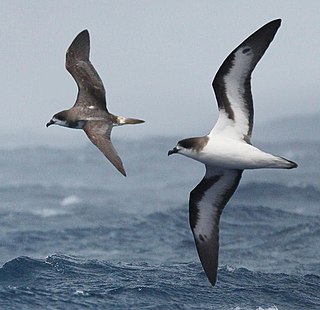
The Bermuda petrel is a gadfly petrel. Commonly known in Bermuda as the cahow, a name derived from its eerie cries, this nocturnal ground-nesting seabird is the national bird of Bermuda and can be found pictured on Bermudian currency. It is the second rarest seabird on the planet and a symbol of hope for nature conservation. They are known for their medium-sized body and long wings. The Bermuda petrel has a greyish-black crown and collar, dark grey upper-wings and tail, white upper-tail coverts and white under-wings edged with black, and the underparts are completely white.

Llyn Brenig is a reservoir located on Denbigh Moors in North Wales. The artificial lake, which was constructed between 1973 and 1976, was created by building an embankment dam across the Afon Brenig valley. It lies at 1,200 ft (370 m) above sea level on the border between the counties of Conwy and Denbighshire. It is used to manage the flow in the River Dee as part of the River Dee regulation system.
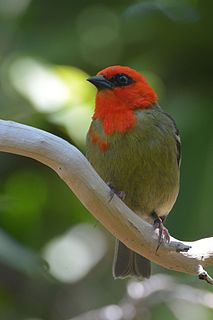
The Mauritius fody is a rare species of bird in the weaver family. It is endemic to the island of Mauritius. It is classified by BirdLife International as being endangered. It is also on the United States' Endangered Species List with an endangered status.

The Clywedog Reservoir is a reservoir near Llanidloes, Wales on the head-waters of the River Severn. The construction of the reservoir was enabled by an Act of Parliament which asserted that "At certain times the flow of water in the river is inadequate ... unless that flow were regulated so as to ensure that at those times water in addition to the natural flow will flow down the river."
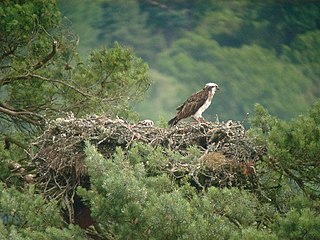
The osprey is a medium large raptor which is a specialist fish-eater with a worldwide distribution. The subspecies Pandion haliaetus haliaetus is native to Eurasia and is found in the British Isles, where it is a scarce breeder primarily in Scotland with smaller numbers in England and Wales. It became extinct in the British Isles in 1916, but recolonised in 1954. Scandinavian birds migrate through Britain on the way to their breeding sites.

Gould's petrel is a species of seabird in the family Procellariidae. The common name commemorates the English ornithologist and bird artist John Gould (1804-1881).
The Glaslyn Osprey Project is located in the Glaslyn Valley at Pont Croesor near Porthmadog in Gwynedd, north-west Wales. The project has supported ospreys since 2004 when they came to the Snowdonia National Park to breed after being absent from Wales for decades. The ospreys spend every winter in West Africa and travel thousands of miles to return to Glaslyn every year to breed and raise their chicks.
Boondelbah Island, also known as the Boondelbah Nature Reserve, is a protected nature reserve and uninhabited island lying 2 kilometres (1.2 mi) off the mouth of Port Stephens on the coast of New South Wales, Australia. The 14-hectare (35-acre) reserve and island is one of two breeding sites of the nominate subspecies of the threatened Gould's petrel and, with the nearby Cabbage Tree Island which hosts the principal colony, has been classified by BirdLife International as an Important Bird Area.

The Dyfi Osprey Project is a conservation project at the Cors Dyfi nature reserve near Derwenlas, in the county of Powys, Wales, under the management of the Montgomeryshire Wildlife Trust.

The New Zealand Department of Conservation has introduced a number of animal and plant species to Mana Island, near Porirua, New Zealand, as part of an ecological restoration programme since taking over conservation management of the island in 1987. Some were reintroductions of species wiped out during years of agricultural use or the subsequent explosion in the number of house mice on the island. A pest control programme eliminated the mice by 1990 and many species have been introduced since. Notable successes include the spotted skink, Duvaucel's gecko and the flax weevil, which are now regarded as well established, and the yellow-crowned parakeet, which has been described as abundant and widespread. Attempts have been made to introduce several seabird species in what the Department of Conservation describes as "the world's most complex seabird translocation project"; results have been mixed.
References
- 1 2 Spring Watch. BBC. 26 May 2015.
- ↑ "Breeding at Rutland Water". Rutland Ospreys. Retrieved 9 April 2017.
- 1 2 "The Translocation Project". Rutland Ospreys. Archived from the original on 24 March 2011. Retrieved 10 March 2020.
- ↑ Tim M. "Ospreys at Rutland Water". Rutland Water Nature Reserve. Retrieved 10 March 2020.
- ↑ "Rutland Water". Roy Dennis Wildlife Foundation. Retrieved 10 March 2020.
- 1 2 3 4 "Translocation - results so far". Rutland Ospreys. 2002. Archived from the original on 11 January 2003. Retrieved 11 March 2020.
- 1 2 3 "About the Rutland Ospreys". Leicestershire and Rutland Wildlife Trust. 03(97) - Mr Rutland. Retrieved 11 March 2020.
{{cite web}}: CS1 maint: location (link) - 1 2 3 David Cobham (2014). A Sparrowhawk's Lament: How British Breeding Birds of Prey Are Faring. Princeton University Press. p. 39. ISBN 9781400850211.
- ↑ "Bird-watchers catch 'thrilling' trout-hungry ospreys on camera". BBC News. 27 July 2019. Retrieved 11 March 2020.
- ↑ Tim M (n.d.). "Osprey chicks and BBC Springwatch". Rutland Water Nature Reserve. Archived from the original on 4 March 2016. Retrieved 4 December 2019.